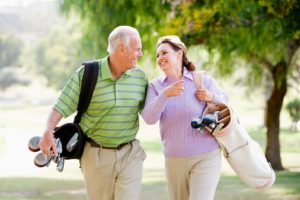 Is golf really a sport? A lot of people feel that because it doesn’t require rigorous athletic preparation and regular training, it isn’t. On the other hand, the broader definition of sport as a physical activity for pleasure encompasses golf.
Is golf really a sport? A lot of people feel that because it doesn’t require rigorous athletic preparation and regular training, it isn’t. On the other hand, the broader definition of sport as a physical activity for pleasure encompasses golf.
Mainstream media often portrays golf as a way for professionals and entrepreneurs to discuss their business matters in a laid-back, informal atmosphere. But the game is also quite popular, especially for older people, as a way to get outside and move around.
Advertisement
Like any other sport, it is fun and competitive. But unlike many types of physical activity, golfing is a sport for people with varying levels of fitness and athletic aptitude. When practiced correctly, golfing can help tone muscles, build endurance and strength, and even help maintain bone health.
Golfing for bones
Bone loss, or osteoporosis, is a pressing concern for the elderly crowd. Incidentally, golfing is a sport that is most commonly played by people in more or less the same age category. Kudos for them, as golfing can be quite beneficial for bone health if done in a safe manner.
With proper form, golfing puts sufficient stress on bones to help them maintain strength and density. The main components of the game—brisk walking and swinging—promotes bone renewal as you support the weight of your body. Like any physical activity, golfing contributes to stronger muscles and helps with balance, which means a lower risk of falls—one of the main causes of fractures in seniors. As you swing the club, your body works to maintain your posture, improving your coordination and flexibility over time.
There’s another benefit of golf for bone health. As an outdoor sport, golfing exposes you to natural sunlight. A quick round of golf outdoors boosts your production of vitamin D, which is essential for calcium absorption. Of course, you need to exercise caution when out in the sun. To avoid sunburns, expose your skin to the sun in the early morning or late afternoon hours, when the sun is not as strong, for 10–20 minutes.
Golfing safely
You may be excited to golf your way to healthier bones, but you shouldn’t forget that physical activity is associated with some risks. The U.S. Consumer Product Safety Commission states that in 2015, over 131,000 people were admitted to emergency rooms and doctors’ offices with golf-related injuries. Keep in mind the following safety tips whenever you’re planning a golf outing:
- Unless you’re a golf pro, start by training with an expert to learn proper technique.
- Walk to as many holes as you can for extra exercise.
- Keep yourself hydrated by drinking plenty of water.
- Stretch before your round to allow yourself a wider range of motion.
- Keep your back and shoulder muscles in good shape with exercises like wall push-ups and squats, yoga, and pilates.
Advertisement
If you’re skeptical about golfing, or if it’s just not your cup of tea, don’t despair. You can still prevent bone loss by doing something active.
“Any physical activity, like golf, where you are using your upper body and core muscles for your swing and your lower body muscles for brisk walking and maintaining balance is all good for helping prevent osteoporosis,” explained Niki Gonty, a nurse adviser for the National Osteoporosis Society.
Related: Six tips to improve your bone health
